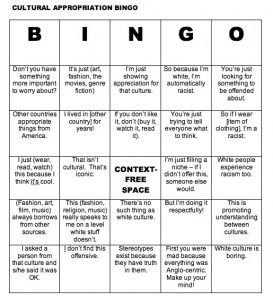Option 2 – A ‘state of the art’ literature review
[Resource: Intellectual Property Issues in Cultural Heritage Project, 2015. Think Before You Appropriate. Things to know and questions to ask in order to avoid misappropriating Indigenous cultural heritage. Simon Fraser University: Vancouver.]
I found the literature I’ve chosen to review while perusing Chelsea Vowel’s blog, where she recommends reading a guide for creators and designers, compiled by IPinCH (The Intellectual Property Issues in Cultural Heritage), an international research initiative based at Simon Fraser University.
The guide interrogates the idea of misappropriation of Indigenous cultures from both legal and ethical angles, appealing specifically to business owners, creators and designers. It isn’t published in any formal academic journals, nor does it directly address the subjects that I wish to focus on in my Big Idea project, i.e. the uninformed or apathetic consumers of culturally appropriative products. However, the principles that it covers are deeply relevant to all members of the supply chain, as well as the users of its products.
The clarity of the language used, as well as the format / design of the guide, which utilizes nested headings, lots of space between paragraphs, and bullet points, makes the guide very accessible and easy to understand, for a range of readers with different levels of proficiency in the English language.
Moreover, the way in which the authors stipulate the definitions of certain relevant terms, evaluate the costs / benefits of each parties’ involvement in cultural exchange, give examples of culturally misappropriative products and anticipate counterarguments, demonstrates an acumen of both perspectives and potentially exacting philosophical / “Devil’s Advocate” interpretations of the guide.
And in a sense, such a comprehensive yet unequivocal inquiry into misappropriation of Indigenous cultures is warranted; designers and creators of white European background continue to steal elements of Aboriginal cultures for the sake of setting or adhering to fashion trends, despite persistent backlash. Ideally, upon being challenged about misappropriation, these “artists” would practise their human quality of compassion and adjust their behaviour accordingly. However, it would seem that a combination of post-Enlightenment hyperrationalism and uninhibited ambitions of increasing profitability has rendered many more privileged folk incapable of exercising empathy when it comes to culturally sensitive issues such as these.
I think that the authors of the guide have recognized this, and have done everything they could have done in 23 pages to convince the reader that cultures as entities in themselves have moral standing and therefore, we have certain duties to respect their traditions and heritage.
To begin, a summary of the motivations and intentions of the guide is given. It states that its main purpose is the unpack important questions such as “Why do products inspired from Indigenous cultural heritage seem to spark particuarly strong reactions and pushback?” and to “underline the mutual benefits of responsible collaboration with Indigenous artists and communities.”
It goes on to clarify the definitions of key terms, such as cultural heritage, tangible heritage, intangible heritage and appropriation before defining misappropriation as “a one-sided process where one entity benefits from another group’s culture without permission and without giving something in return.” The guide stresses the fact that due to existing power imbalances, not only are Intellectual Property (IP) laws typically formulate without regard for Indigenous cultural heritage, but Indigenous peoples, already underprivileged, are less likely to be able to afford the copyright, trademarks, patents, etc. than the companies who reap the profits of the products of this heritage. Moreover, it outlines the fact that IP laws only protect an individual’s creations for a limited time span, whereas products of Indigenous cultures are “developed collectively over many generations.” This is particularly a problem when a people’s wellbeing is largely dependent on the economic returns of their cultural expression.
The following are given, with explanations, as the tenets of a responsible creative collaboration:
- Free prior and informed consent
- Shared control over process and conduct
- Acknowledgement and attribution
- Respect for cultural differences
- Reciprocity and benefit-sharing
Following this, the costs and risks of misappropriation “for you and your company” and, separately, “for Indigenous artists and communities” are given, as well as the benefits of taking part in a responsible collaboration, for the same two parties.
The final sub-heading, “How can you contribute to the ethical treatment of Indigenous cultural heritage?” meticulously addresses common reasons that people give for engaging in cultural misappropriation. These include:
- “It is trendy in my industry, therefore I see it as a good business opportunity”
- “I want to celebrate Indigenous peoples and their creativity”
- “I would like my work to reflect a connection to the Indigenous history and culture of where I live”
To conclude, the guide gives six hypothetical examples of misappropriation of different kinds and degrees, all of which are inspired by real-life cases. These examples, as well as the rest of the guide, can be accessed at the link below:
http://www.sfu.ca/ipinch/sites/default/files/resources/teaching_resources/think_before_you_appropriate_jan_2016.pdf
